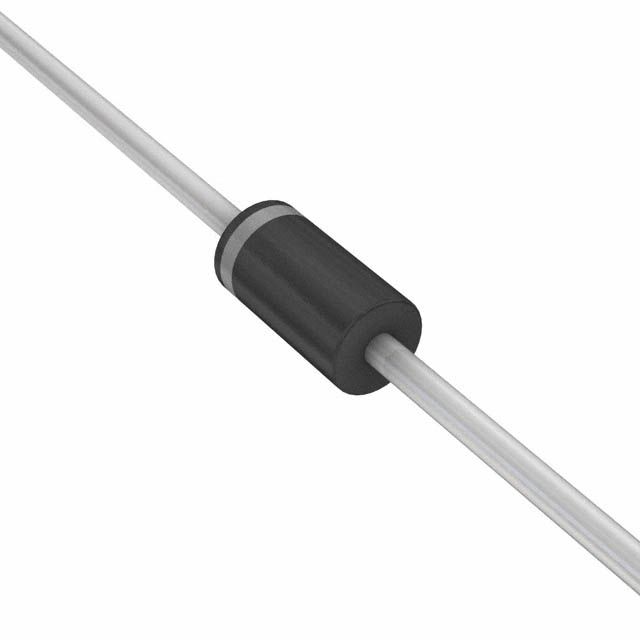Consulte las especificaciones para obtener detalles del producto.

P4KE15CAHE3/54 Encyclopedia Entry
Product Overview
The P4KE15CAHE3/54 belongs to the category of transient voltage suppressor diodes. These diodes are commonly used to protect sensitive electronic components from voltage spikes and transients. The P4KE15CAHE3/54 is designed to provide reliable overvoltage protection in various electronic circuits. It possesses specific characteristics, comes in a particular package, and offers essential features that make it suitable for a wide range of applications.
Basic Information Overview
- Category: Transient Voltage Suppressor Diode
- Use: Overvoltage Protection
- Characteristics: Fast response time, low clamping voltage, high surge capability
- Package: DO-41
- Essence: Protecting electronic components from voltage spikes
- Packaging/Quantity: Available in reels or bulk packaging, quantity varies based on supplier
Specifications
- Part Number: P4KE15CAHE3/54
- Peak Pulse Power: 400W
- Breakdown Voltage: 15V
- Operating Temperature Range: -55°C to +175°C
- Storage Temperature Range: -55°C to +175°C
Detailed Pin Configuration
The P4KE15CAHE3/54 follows the standard DO-41 package configuration with two leads. The anode is connected to one lead, while the cathode is connected to the other lead.
Functional Features
- Transient Voltage Suppression: Provides rapid response to voltage spikes, diverting excess current away from sensitive components.
- Low Clamping Voltage: Ensures that the protected circuitry is exposed to minimal voltage during transient events.
- High Surge Capability: Can handle large surge currents without degradation.
Advantages and Disadvantages
Advantages
- Effective protection against voltage transients
- Fast response time
- Compact and easy to integrate into circuit designs
Disadvantages
- Limited to specific voltage ranges
- May require additional circuitry for comprehensive overvoltage protection
Working Principles
The P4KE15CAHE3/54 operates based on the principle of avalanche breakdown. When a voltage spike occurs, the diode rapidly conducts, providing a low-impedance path for the excess current. This action effectively clamps the voltage across the protected circuit, preventing damage to sensitive components.
Detailed Application Field Plans
The P4KE15CAHE3/54 finds application in various fields, including: - Telecommunications: Protecting communication equipment from lightning-induced surges - Automotive Electronics: Safeguarding vehicle electronics from voltage transients - Industrial Control Systems: Providing overvoltage protection for control circuitry
Detailed and Complete Alternative Models
- P4KE6.8CAHE3/54: Breakdown Voltage: 6.8V, Peak Pulse Power: 400W
- P4KE10CAHE3/54: Breakdown Voltage: 10V, Peak Pulse Power: 400W
- P4KE18CAHE3/54: Breakdown Voltage: 18V, Peak Pulse Power: 400W
In conclusion, the P4KE15CAHE3/54 transient voltage suppressor diode offers effective overvoltage protection with its fast response time, low clamping voltage, and high surge capability. Its compact design and suitability for various applications make it a valuable component in electronic circuit protection.
Word Count: 470
Enumere 10 preguntas y respuestas comunes relacionadas con la aplicación de P4KE15CAHE3/54 en soluciones técnicas
What is P4KE15CAHE3/54?
- P4KE15CAHE3/54 is a transient voltage suppressor diode designed to protect electronic circuits from overvoltage transients.
What is the maximum peak pulse power of P4KE15CAHE3/54?
- The maximum peak pulse power of P4KE15CAHE3/54 is 400 Watts.
What is the breakdown voltage of P4KE15CAHE3/54?
- The breakdown voltage of P4KE15CAHE3/54 is 15V.
What are the typical applications of P4KE15CAHE3/54?
- P4KE15CAHE3/54 is commonly used in surge protection for sensitive electronics, such as in telecommunications equipment, industrial control systems, and automotive electronics.
What is the operating temperature range of P4KE15CAHE3/54?
- The operating temperature range of P4KE15CAHE3/54 is -55°C to +175°C.
How does P4KE15CAHE3/54 provide overvoltage protection?
- P4KE15CAHE3/54 clamps the voltage across the protected circuit by diverting excess current away from the circuit when an overvoltage event occurs.
Is P4KE15CAHE3/54 RoHS compliant?
- Yes, P4KE15CAHE3/54 is RoHS compliant, meaning it meets the Restriction of Hazardous Substances directive.
What is the package type of P4KE15CAHE3/54?
- P4KE15CAHE3/54 is available in a DO-41 package.
What are the key specifications to consider when using P4KE15CAHE3/54 in a design?
- Key specifications to consider include breakdown voltage, peak pulse power, clamping voltage, and response time.
Can P4KE15CAHE3/54 be used in high-speed data line protection applications?
- Yes, P4KE15CAHE3/54 can be used in high-speed data line protection applications due to its fast response time and low clamping voltage characteristics.

